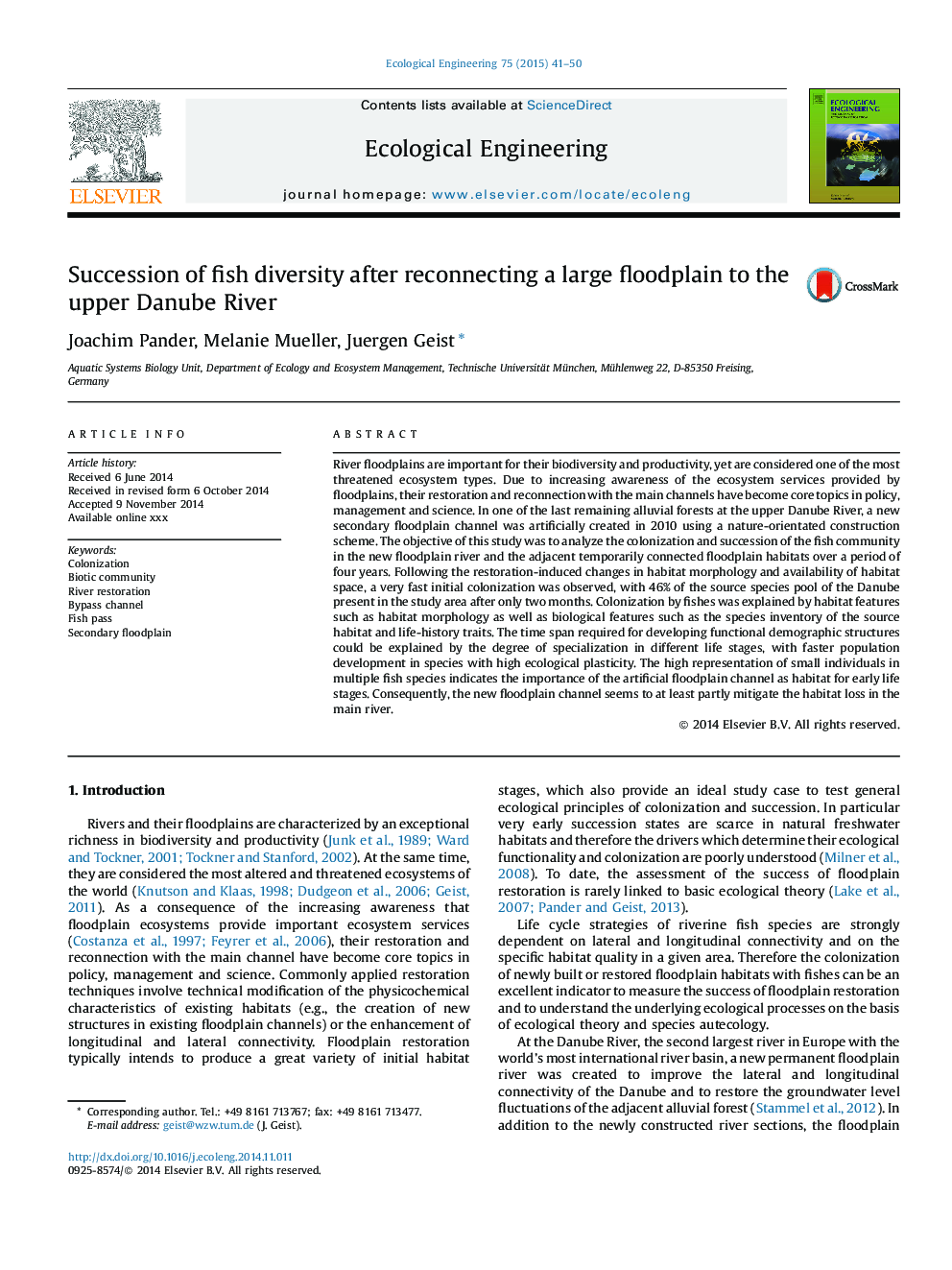| کد مقاله | کد نشریه | سال انتشار | مقاله انگلیسی | نسخه تمام متن |
|---|---|---|---|---|
| 6301653 | 1618024 | 2015 | 10 صفحه PDF | دانلود رایگان |
عنوان انگلیسی مقاله ISI
Succession of fish diversity after reconnecting a large floodplain to the upper Danube River
ترجمه فارسی عنوان
پیروی از تنوع ماهی ها پس از اتصال یک سیلاب بزرگ به رودخانه دانوب بالا
دانلود مقاله + سفارش ترجمه
دانلود مقاله ISI انگلیسی
رایگان برای ایرانیان
کلمات کلیدی
کلونیزاسیون، جامعه زیستی، ترمیم رودخانه، کانال دور زدن عبور ماهی، سیلاب ثانویه،
ترجمه چکیده
سیلاب های رودخانه ای برای تنوع زیستی و بهره وری آنها مهم هستند، اما یکی از تهدید ترین انواع اکوسیستم ها محسوب می شود. با توجه به افزایش آگاهی از خدمات اکوسیستم ارائه شده توسط سیلاب، ترمیم و دوباره متصل شدن با کانال های اصلی تبدیل شده اند موضوع اصلی در سیاست، مدیریت و علم است. در یکی از آخرین جنگل های آبرفت باقی مانده در رودخانه دانوب بالا، یک کانال سیلابی ثانویه جدید به طور مصنوعی در سال 2010 با استفاده از طرح ساختاری متمرکز طبیعت ایجاد شد. هدف از این مطالعه، تجزیه و تحلیل استعمار و پیگیری جامعه ماهی در رودخانه سیلاب جدید و زیستگاه های سواحل شبه مواجه مجاور مجاور در طول چهار سال است. پس از تغییرات ناشی از ترمیم در مورفولوژی زیستگاه و در دسترس بودن فضای زیستگاه، کلونیزاسیون سریع بسیار سریع آغاز شد و 46٪ از کلون منبع دانا در منطقه مورد مطالعه پس از تنها دو ماه مشاهده شد. کلونیزاسیون توسط ماهی ها با ویژگی های زیستگاه مانند مورفولوژی زیستگاه و همچنین ویژگی های بیولوژیکی مانند موجودی گونه زیستگاه منبع و ویژگی های تاریخ زندگی توضیح داده شده است. مدت زمان لازم برای ساخت ساختارهای جمعیت شناختی کاربردی می تواند با درجه تخصص در مراحل مختلف زندگی همراه با توسعه سریع جمعیت در گونه های با پلاستیک اکولوژیکی بالا توضیح داده شود. نمایندگی بالای افراد کوچک در گونه های مختلف ماهی، اهمیت کانال سیلابی مصنوعی را به عنوان زیستگاه برای مراحل اولیه زندگی نشان می دهد. در نتیجه، کانال سیلاب جدید به نظر می رسد حداقل تا حدی کاهش زیستگاه در رودخانه اصلی را کاهش دهد.
موضوعات مرتبط
علوم زیستی و بیوفناوری
علوم کشاورزی و بیولوژیک
بوم شناسی، تکامل، رفتار و سامانه شناسی
چکیده انگلیسی
River floodplains are important for their biodiversity and productivity, yet are considered one of the most threatened ecosystem types. Due to increasing awareness of the ecosystem services provided by floodplains, their restoration and reconnection with the main channels have become core topics in policy, management and science. In one of the last remaining alluvial forests at the upper Danube River, a new secondary floodplain channel was artificially created in 2010 using a nature-orientated construction scheme. The objective of this study was to analyze the colonization and succession of the fish community in the new floodplain river and the adjacent temporarily connected floodplain habitats over a period of four years. Following the restoration-induced changes in habitat morphology and availability of habitat space, a very fast initial colonization was observed, with 46% of the source species pool of the Danube present in the study area after only two months. Colonization by fishes was explained by habitat features such as habitat morphology as well as biological features such as the species inventory of the source habitat and life-history traits. The time span required for developing functional demographic structures could be explained by the degree of specialization in different life stages, with faster population development in species with high ecological plasticity. The high representation of small individuals in multiple fish species indicates the importance of the artificial floodplain channel as habitat for early life stages. Consequently, the new floodplain channel seems to at least partly mitigate the habitat loss in the main river.
ناشر
Database: Elsevier - ScienceDirect (ساینس دایرکت)
Journal: Ecological Engineering - Volume 75, February 2015, Pages 41-50
Journal: Ecological Engineering - Volume 75, February 2015, Pages 41-50
نویسندگان
Joachim Pander, Melanie Mueller, Juergen Geist,
